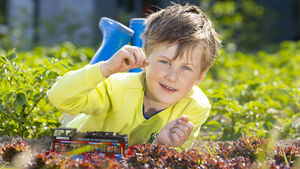Green Fingers: Last dance for growing some food crops

Pictured launching the call to action for ‘Get Ireland Growing’ Day 2023 was Harry Molloy, age 5. GIY, the social enterprise, encouraged households and businesses across Ireland to take time to ‘sow a seed’ and Get Ireland Growing. Photo: Patrick Browne
The growing season is reasonably short in Ireland, therefore, as the period for sowing and planting is limited, it is important to get going when conditions are reasonable.
Unfortunately this year, we lost some of the normal time for planting due to adverse weather conditions, and it is a case of catching up and hoping that we manage to harvest some crops before the end of the summer.
For ease of cropping under more favourable conditions, there has been an increased use of protected cropping, which means growing plants under cover with structures such as a tunnel, conservatory or glasshouse.
If you have the space do consider installing some protected cropping, and of course, it is probably the only way you can grow tomatoes, peppers, aubergines, cucumbers and melons.
The choice of what to sow has been reduced to a handful, and includes French and broad beans, beetroot, carrots, salads, including lettuce, peas, radishes, spinach and Swedes.
There are still a limited range of young plants available for planting out direct - usually members of the cabbage family and for inside tomatoes, peppers and cucumbers.
There are also an increasing number of people who want to grow a few fresh potatoes to eat at Christmas, and for those who wish to have a go, it is just a matter of using some of your own surplus tubers that you might be harvesting now or use some sprouted ones left in a bag from shopping.
Grow in the normal way in drills or in containers, and with containers you can take them under cover when there is frost about later in the season and leave them until ready to harvest.
These are the group, which includes strawberries, raspberries and blackcurrants among many others, and they come into fruit in a short time and do not require much space in which to grow in.
Traditionally, they are grown in the ground but, increasingly, many are grown in containers of some sort due to a number of reasons, but first of all containers need to be a reasonable size, otherwise they dry out too quickly, so I suggest a bucket size as being the minimum dimension to use.
Container-grown plants are mobile and can be moved about into an area that suits you, such as the patio or other outdoor seating area, and a good way to grow if a modest amount of fruit is desired. Part of the attraction might be in the concept of a pleasing visual appearance.
Blueberries are particularly attractive when grown this way and, in their final burst before winter, have colourful autumn leaves.
If you wish to have a larger quantity of fruit, then it is more practical to have them grown directly in the soil.
It is sometimes difficult to know how many plants are needed to produce a decent quantity of the required fruit and as a guideline for four people I will mention some fruiting plants, together with the number of plants suggested in brackets: Strawberries and raspberries (10-15), blueberries (two to four), gooseberries and blackcurrants (one to two).
Fast-growing plants such as flowers and vegetables will need regular watering, regardless of whether there are periods of light rain.
Watering in the evening or morning is best, preferably when it is not sunny.
We feed plants twice a month usually on the weekend when there is no rush and maybe trim or remove faded flowers at the same time.
If you have any queries or comments you are welcome to share them with me on 051 384273 or orchardstowngardencentre@hotmail.com and if of general interest I will include it in a future newsletter.






